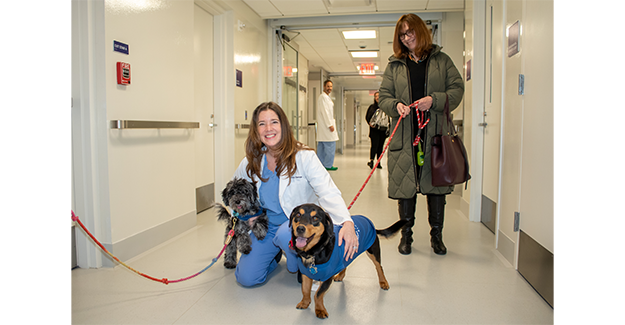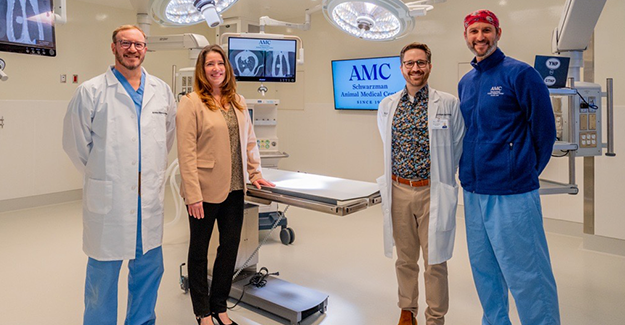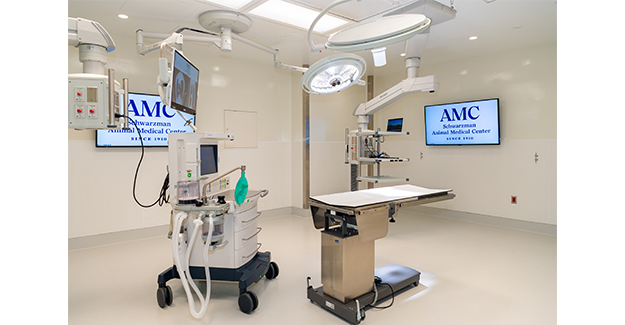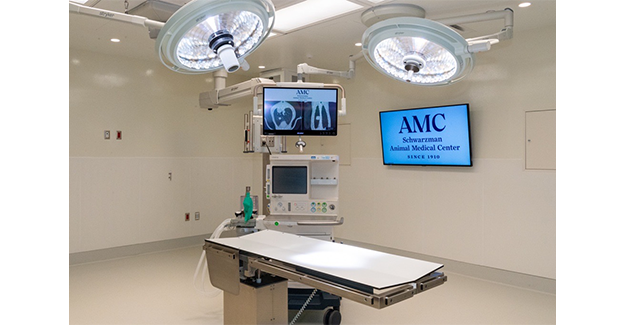World’s largest nonprofit animal hospital opens state-of-the-art surgical suite
 Head of Surgery Pamela Schwartz, DVM, DACVS, CCRP, (and friends) at the Schwarzman Animal Medical Center’s new surgical center
Head of Surgery Pamela Schwartz, DVM, DACVS, CCRP, (and friends) at the Schwarzman Animal Medical Center’s new surgical center
The Schwarzman Animal Medical Center (AMC) of New York City recently announced that their new surgical suite renovation, The Denise and Michael Kellen Institute for Surgical Care, is now open for use.
This state-of-the-art suite spanning more than 7,000 square feet is just the first part of a complete renovation of an animal hospital that serves as both a general practice clinic for some pets and a referral center for many others.
When completed in 2025, the $100-million renovation of the 83,000-square-foot hospital will include an expanded emergency room with a trauma OR, a new intensive care unit, a surgical care unit with a large isolation ward, and an exotics ward.
To learn more, I met with Helen Irving, RN, MBA, CEO and president of AMC, Pamela Schwartz, DVM, DACVS, CCRP, department head of surgery and service head of the Surgical Service 3 team, and Daniel Spector, DVM, DACVS, service head of the Surgical Service 2 team.
They explained how the new surgical suite, along with the hospital’s missions to teach, improve access to care, and support client and staff wellness, makes AMC a unique and empowering place to work.
“There isn’t anything we can’t do”
Spector has operated in the new surgical suite and already feels a difference. “Clinically speaking, it allows us to do so much more than we could in terms of types of procedures,” he said.
The surgery unit specializes in minimally invasive surgical procedures that benefit from the new center’s advanced technology and intentionally designed layout.
Five new operating rooms, a minor procedure room, and recovery rooms separate cats from dogs, which makes it possible for more to happen at once and allows for the hiring of more surgeons to accommodate the demand for their services.
AMC often takes the most complicated cases—ones that require a lot of collaboration among various specialties to treat appropriately.
“We are frequently a stop when everyone else says it cannot be done,” Spector said.
Schwartz adds, “Everyone [at AMC] wants to push the envelope. There isn’t anything we can’t do.”
This includes having one of very few veterinary surgical oncologists in the world on staff, using interventional radiology, and performing laparoscopic procedures whenever possible.

Schwarzman Animal Medical Center surgeons (Left to right): Robert Hart, DVM, DACVS; Pamela Schwartz, DVM, DACVS, CCRP; Jonathan Ferrari, VMD, DACVS (SA), ACVS Fellow; Daniel Spector, DVM, DACVS-SA


Designed to support wellbeing
According to Spector, the updated surgical space has already made a “very palpable” improvement in the mental and emotional states of hospital personnel, patients, and pet owners. Not only is the new space three times larger, but it’s brighter and incorporates more natural light.
Spector has noticed that these changes have created an increased sense of calm among both humans and animals. “People are smiling more,” he adds.
After operating on a New York Police Department K9 officer in the new space, he noted the benefits of the dog being able to recover with his handler away from everything else. Cats also now have the benefit of recovering in their own area, away from the sight, sound, and smell of dogs.
A mission to teach
Another part of AMC’s mission is teaching—including formal training for veterinary externs, interns, and residents, as well as credentialed veterinary technicians.
This shows up in the new surgical suite’s design, which is decked out with cameras and screens everywhere. The surgical lights even have cameras in the handles. And increased space in the renovated suite allows for more people to be in the OR without breaking sterility.
A key part of the technician training program is the focus on helping to build a career path for technicians, Irving said. She wants veterinary technicians to look at career options they can pursue with their current credentials and say, “I want to do that one day!”
So in addition to a clinical pathway for technician training, AMC also has a management pathway (to prepare technicians for leadership roles) and an education pathway (to help prepare technicians to be instructors).
These programs can be an onramp for technicians who want to specialize and obtain their VTS credentials as well.
“Renovating” how the team works together
In addition to the physical changes to the hospital, AMC has made some renovations to how it operates. To further support the emotional health of the hospital staff and clients, AMC hired a veterinary social worker and a social work intern who coordinate wellness activities and act as liaisons between pet owners and staff.
The hospital has also embraced flexibility in scheduling, and with the advent of telehealth, opportunities to work from home during designated telehealth shifts.
Making care accessible
But none of these innovations are worth it unless the patients and their owners can afford treatment. To improve access to care, AMC offers financial assistance programs for pet owners, including programs to cover specific needs such as cancer care, emergency care, rehabilitation care, services for senior pet owners, and services for military personnel. Such programs are funded by charitable donations and by the hospital itself.
Post-pandemic, AMC has also embraced telehealth to reduce the need for multiple visits to the clinic. In addition to reducing stress on pet owners who may struggle to get to the hospital, this also helps pets who are fearful when seeing the vet. Schwartz explains that many pre-surgical consultations will be conducted via telehealth so that the pet and their owner only need to go to the clinic on the day of their procedure.
Opening in 2025
AMC works hard to be a hospital that pet owners choose to visit for their pets’ needs and that veterinary professionals want to be a part of. With all the planned renovations, the hospital will be better suited to accomplish these goals.
“Watch this space,” Irving advises. “Come next April, AMC is going to look beautiful again.”
Emily Singler, VMD, is AAHA’s Veterinary Content Specialist.
Photo credits: Joy Glenn
Disclaimer: The views expressed, and topics discussed, in any NEWStat column or article are intended to inform, educate, or entertain, and do not represent an official position by the American Animal Hospital Association (AAHA) or its Board of Directors.



